“2835 LED strips provide higher brightness, efficiency, and heat dissipation, ideal for detailed and task-oriented lighting. 3528 LED strips offer moderate brightness, lower energy use, and cost-effectiveness, perfect for ambient or decorative lighting. Clearly understanding these differences helps you select the ideal LED strip for your project.”
Introduction to 2835 and 3528 LED Strips
Having worked extensively with different LED strip types, I’d like to clearly explain the differences between the popular 2835 and 3528 LED strips. Understanding these clearly can significantly help you choose the best option tailored specifically to your lighting needs.
What is a 2835 LED Strip?
The 2835 LED strip uses LEDs sized 2.8mm × 3.5mm. From my practical experience, 2835 LEDs offer high brightness levels and excellent efficiency, typically providing around 22-24 lumens per LED. They also have superior heat dissipation, making them ideal for task-oriented lighting or spaces requiring consistent brightness.
What is a 3528 LED Strip?
3528 LED strips utilize LEDs sized 3.5mm × 2.8mm. They generally offer moderate brightness averaging around 6-7 lumens per LED. These LED strips are often chosen for ambient or decorative lighting applications due to their lower energy consumption and more affordable price point.
People often ask me, “Which is brighter, 2835 or 3528 LED strips?” Clearly, 2835 LED strips are significantly brighter and more efficient, making them the preferred choice for detailed, task-focused illumination projects.
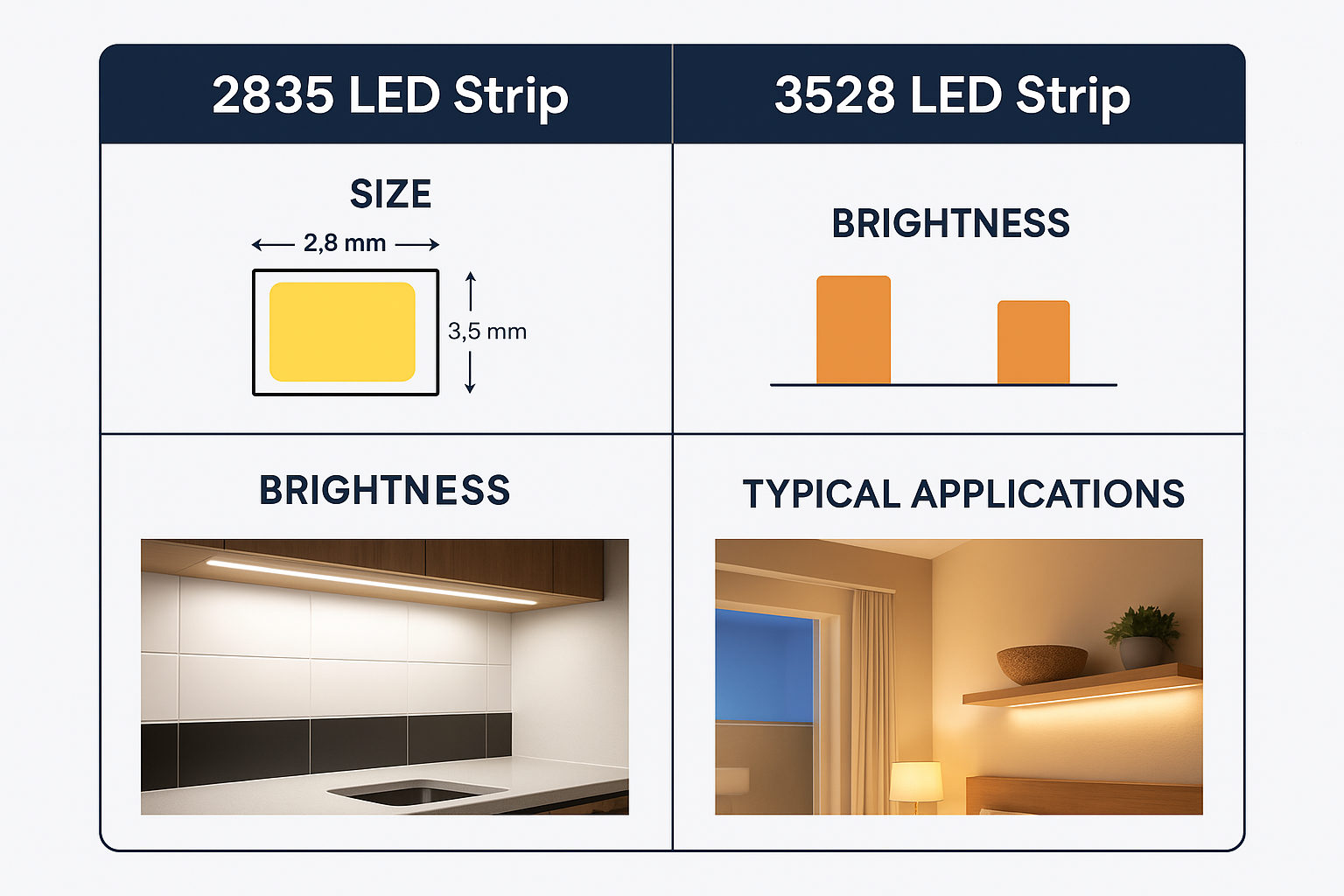
Technical Differences Clearly Explained
Based on my personal experience installing various LED strips, understanding the technical differences between 2835 and 3528 LED strips is crucial. Here’s a straightforward breakdown of their technical distinctions to help you make the right choice.
Brightness & Lumen Output
- 2835 LED Strips:
Clearly deliver higher brightness, typically ranging from 22 to 24 lumens per LED. Ideal for spaces requiring detailed, task-oriented lighting.
- 3528 LED Strips:
Offer moderate brightness, approximately 6 to 7 lumens per LED. Suitable for ambient or decorative lighting applications where intense illumination isn’t necessary.
Energy Efficiency & Power Consumption
- 2835 LED Strips:
Clearly provide superior efficiency, delivering higher brightness with lower overall power consumption, making them cost-effective in the long run.
- 3528 LED Strips:
Generally consume less power due to lower brightness levels, ideal for scenarios focused on energy-saving, decorative illumination.
People frequently ask me, “How bright is a 2835 LED compared to a 3528?” In my installations, I’ve found 2835 LEDs significantly brighter and more efficient, clearly outperforming 3528 LEDs for task lighting and detailed illumination.
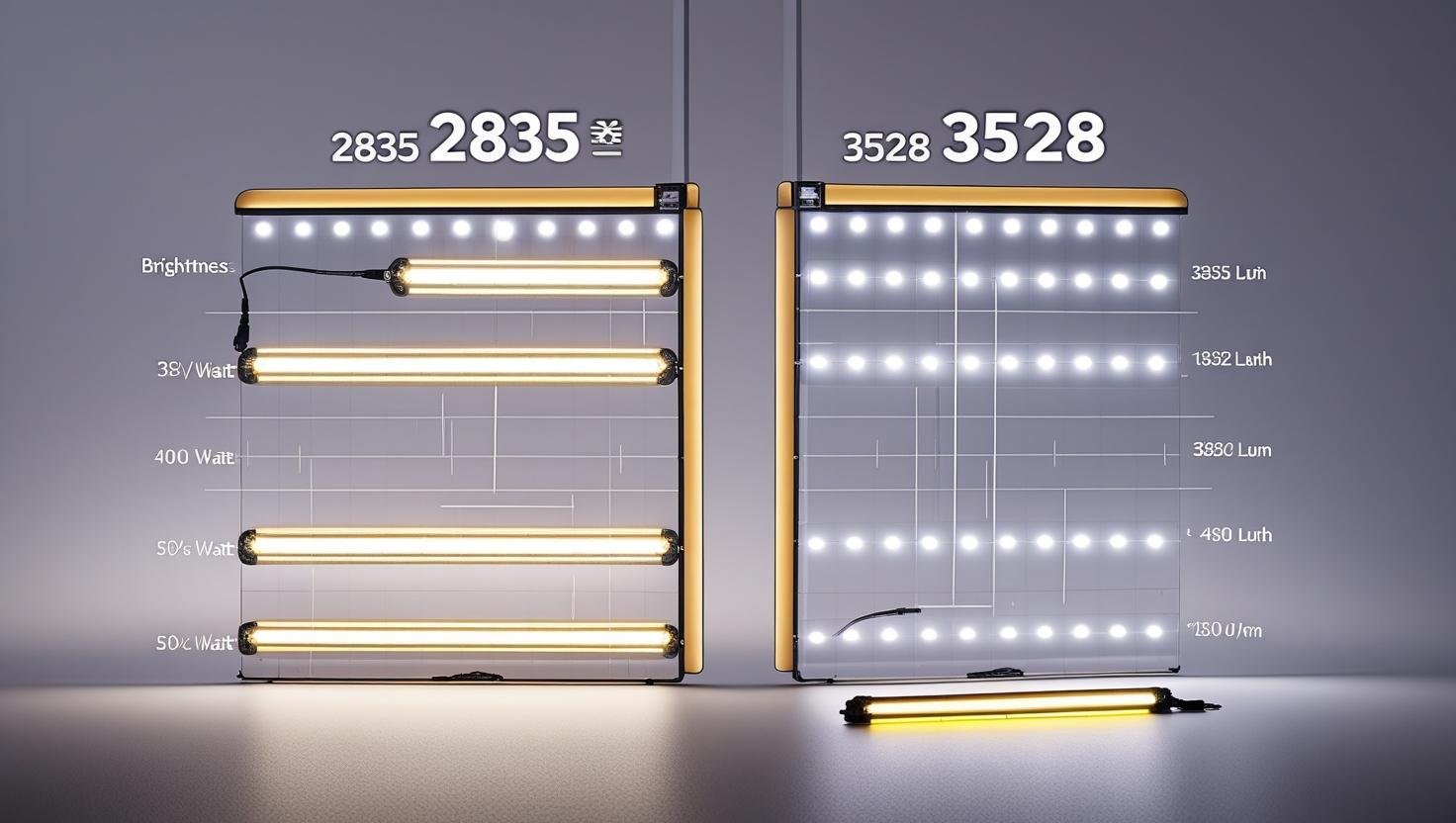
Advantages and Disadvantages of 2835 LED Strips
Having personally installed numerous 2835 LED strips, I understand their strengths and limitations clearly. Here’s my practical perspective to guide your choice.
Advantages of 2835 LED Strips
- Higher Brightness and Efficiency:
Clearly deliver superior illumination with higher lumen output per LED, making them perfect for detailed, task-focused lighting applications.
- Better Heat Dissipation:
Efficient design helps maintain lower operating temperatures, enhancing longevity and reliability.
- Cost-Effective in the Long Run:
Due to higher efficiency, clearly reducing long-term energy consumption and associated costs.
Disadvantages of 2835 LED Strips
- Higher Initial Cost:
Typically more expensive upfront compared to 3528 LED strips, which might impact budget considerations.
- Installation Complexity:
May require careful heat management strategies and specific power supply considerations due to higher brightness.
Many people ask me, “Are 2835 LEDs suitable for residential lighting?” Clearly, if your home project involves task-oriented lighting such as kitchens, offices, or detailed interior lighting, 2835 LED strips are an ideal and efficient choice.
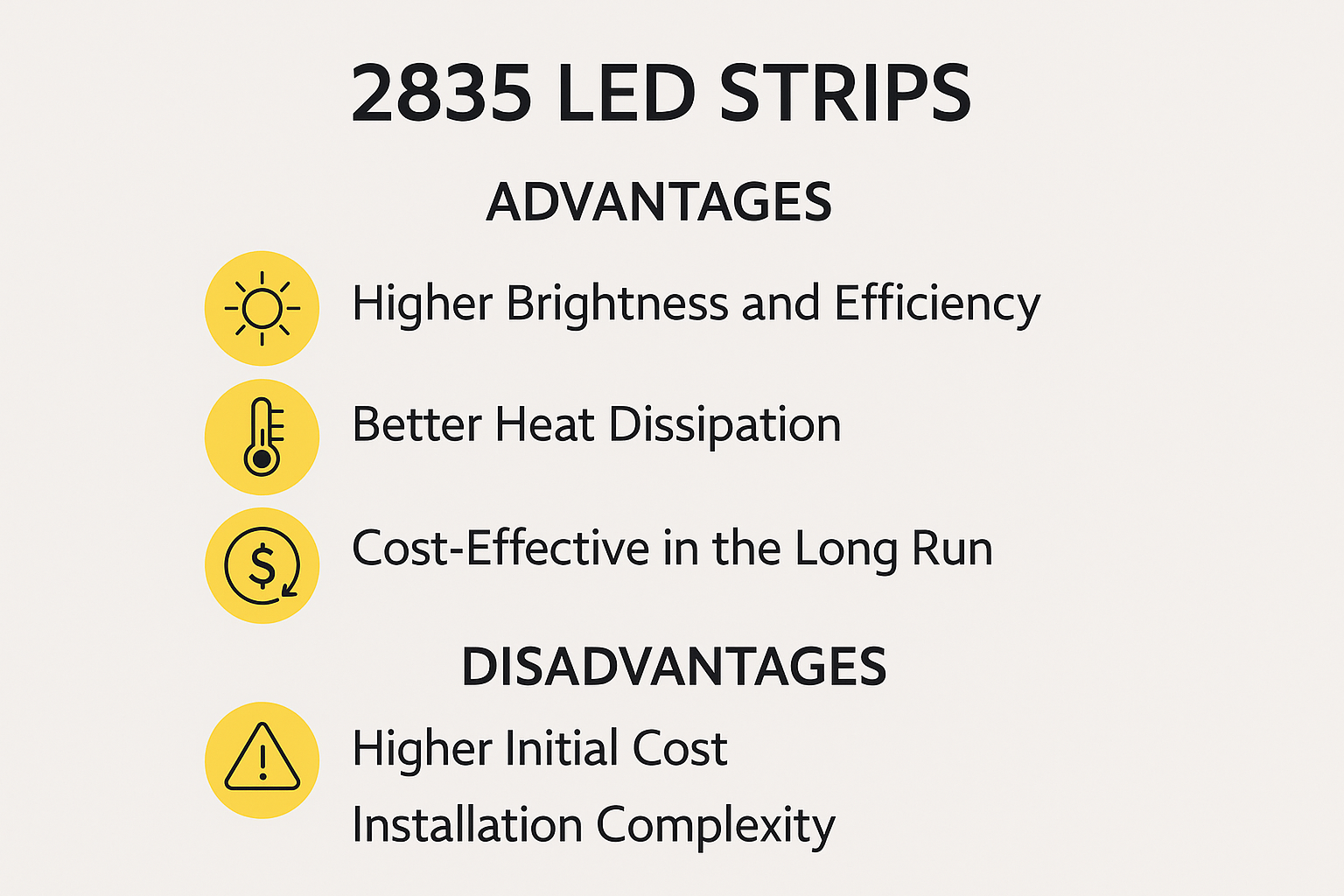
Advantages and Disadvantages of 3528 LED Strips
Based on my hands-on experience installing 3528 LED strips, I’ll clearly outline their advantages and potential limitations. Understanding these will help you determine if they align with your project’s specific requirements.
Advantages of 3528 LED Strips
- Cost-Effective:
Typically more affordable, making them ideal for budget-sensitive projects that require basic decorative or ambient lighting.
- Lower Energy Consumption:
Clearly use less power due to their moderate brightness levels, suitable for energy-conscious installations.
- Ease of Installation:
Often easier to install, handle, and manage, ideal for DIY applications and general indoor lighting projects.
Disadvantages of 3528 LED Strips
- Limited Brightness:
Clearly offer significantly less brightness compared to 2835 strips, making them unsuitable for detailed, task-oriented lighting.
- Reduced Lighting Uniformity:
May provide less uniform illumination, potentially requiring closer spacing or higher density to achieve desired effects.
Many clients frequently ask me, “Are 3528 LEDs bright enough for general home use?” From my experience, 3528 LED strips are well-suited for general ambient or decorative purposes, providing sufficient illumination for comfortable residential environments, but they fall short in applications demanding higher intensity or detailed lighting.
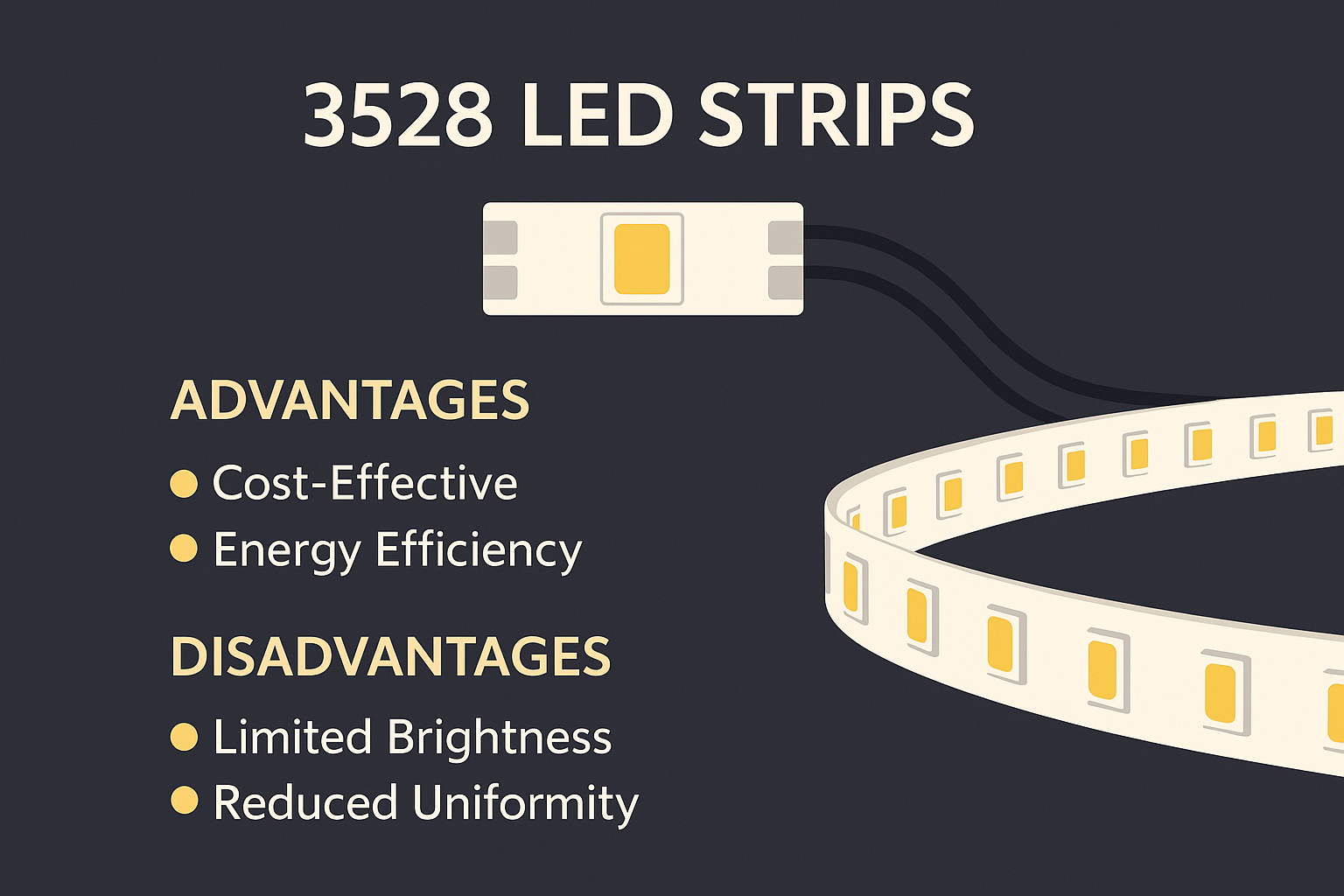
Best Applications & Practical Scenarios
Having installed numerous lighting setups using both 2835 and 3528 LED strips, I clearly understand which applications suit each type best. Here’s practical guidance based on my real-world experience to help you choose wisely.
Ideal Uses for 2835 LED Strips
2835 LED strips clearly excel in applications demanding brighter, consistent illumination, including:
- Detailed Task Lighting:
Ideal for kitchens, home offices, and workplaces where clear, strong illumination is essential for tasks.
- Retail and Display Lighting:
Clearly perfect for highlighting products, displays, and merchandise where vibrant, high-quality lighting is necessary.
- Commercial & Professional Settings:
Suitable for offices, commercial buildings, and public spaces requiring efficient, bright, and uniform illumination.
Ideal Uses for 3528 LED Strips
3528 LED strips clearly perform best in environments where moderate brightness and cost efficiency are priorities, such as:
- Residential Ambient Lighting:
Ideal for living rooms, bedrooms, and general indoor spaces where gentle, ambient illumination is preferred.
- Decorative & Accent Lighting:
Clearly excellent for highlighting furniture, architectural details, or creating subtle, cozy atmospheres.
- Budget-Friendly Lighting Projects:
Perfect for cost-sensitive installations that require good-quality lighting without high brightness demands.
Clients frequently ask me, “Can I use 3528 LED strips in task-oriented spaces?” Clearly, while 3528 LED strips offer moderate brightness suitable for general lighting, 2835 LED strips are clearly the better choice for task-focused or high-visibility environments.
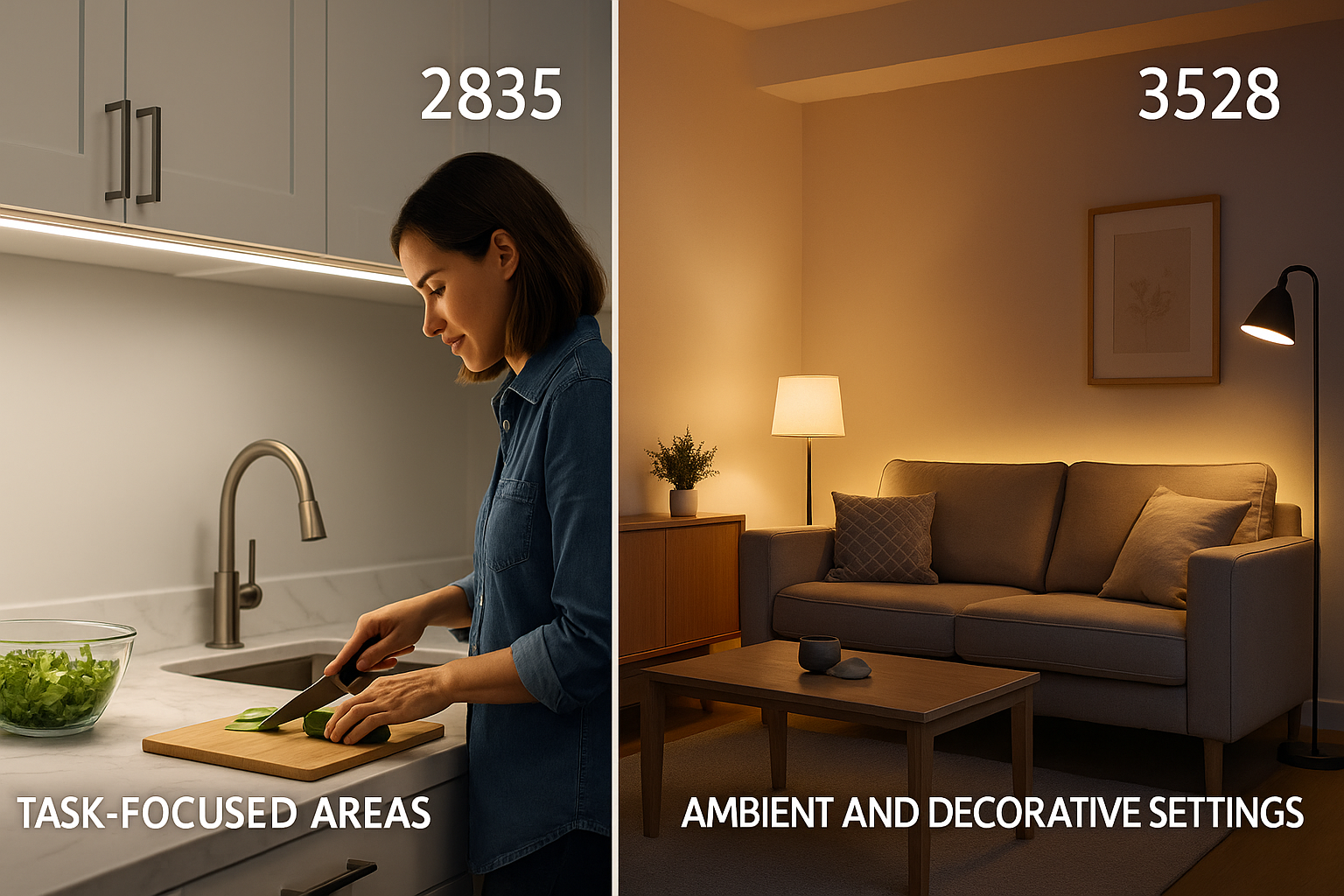
How to Choose Between 2835 and 3528 LED Strips
Drawing from my extensive experience installing both types of LED strips, I clearly understand how to determine which option will best fit your project needs. Here are practical considerations and clear advice for making your selection confidently.
Key Decision Factors
- Brightness Requirements:
If your project clearly demands higher brightness, choose 2835 LED strips. For moderate or ambient lighting, 3528 LED strips are sufficient and cost-effective.
- Application Environment:
Clearly evaluate the lighting application—2835 is ideal for detailed task lighting, retail displays, or high-visibility spaces, while 3528 is perfect for residential or decorative uses.
- Budget Constraints:
Clearly define your budget—3528 LED strips are typically more affordable upfront, suitable for budget-conscious projects.
- Installation Complexity & Power Requirements:
Clearly consider installation ease—3528 LED strips usually involve simpler installation and power planning, whereas 2835 strips may require additional considerations for heat management and power supply.
Common Mistakes and Expert Tips
- Ignoring Brightness Needs:
Many people underestimate or overestimate their lighting requirements. Clearly assess your illumination goals before choosing between 2835 or 3528 LED strips.
- Underestimating Installation & Heat Management:
Clearly account for proper heat dissipation and power supply requirements, particularly when choosing brighter 2835 LED strips.
- Choosing Based Solely on Cost:
Balance initial cost savings against long-term brightness and efficiency clearly, especially if your project requires higher illumination levels.
A common question I often hear is, “Are 2835 LEDs worth the higher initial cost?” Clearly, if consistent brightness, improved efficiency, and long-term reliability matter significantly to your project, then the higher initial investment in 2835 LED strips is well justified.
External Link:
Numbers and LEDs: What does 2835, 3528, and 5050 mean? – HitLights
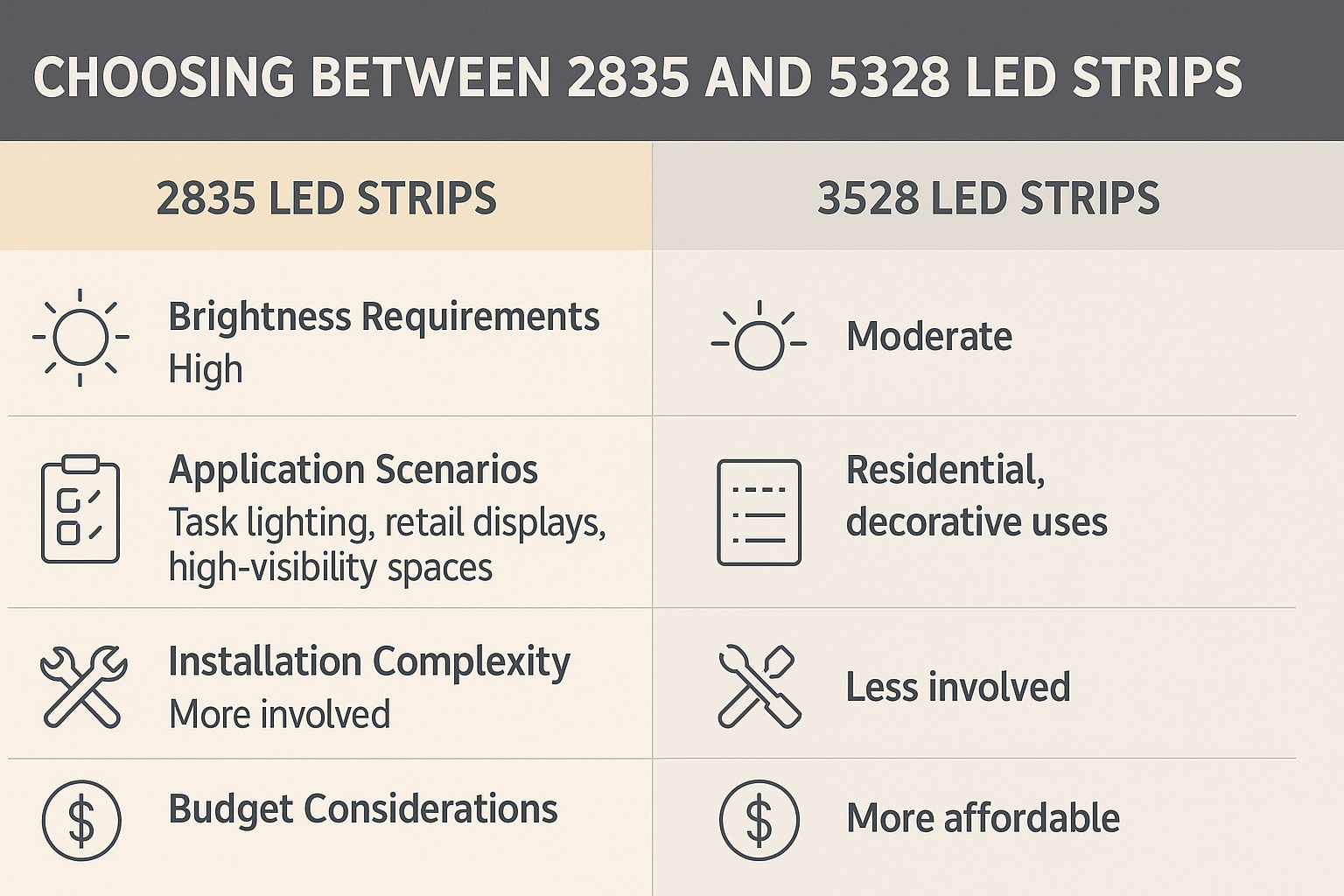
Installation, Maintenance & Expert Recommendations
Having personally installed numerous 2835 and 3528 LED strips, I’ve gathered clear, practical guidance to help you achieve the best performance and longevity from your LED lighting. Here’s my straightforward installation advice, essential maintenance practices, and troubleshooting tips.
Step-by-Step Installation Guide
2835 LED Strips Installation:
- Careful Planning:
Clearly measure and plan the layout, considering the higher brightness and necessary heat dissipation.
- Proper Surface Preparation:
Ensure surfaces are clean, dry, and suitable for secure mounting.
- Mounting and Heat Management:
Use adhesive backing along with aluminum channels or heat sinks clearly designed to handle higher heat output.
- Secure Connections and Testing:
Carefully connect strips to appropriate constant voltage power supplies, clearly verifying correct polarity and performing thorough testing.
3528 LED Strips Installation:
- Easy Preparation:
Clearly define placement areas, considering moderate brightness requirements and simpler installation needs.
- Straightforward Mounting:
Attach strips securely using adhesive backing or mounting clips, suitable for DIY installations.
- Connect and Verify:
Clearly connect to a compatible power source, checking voltage and polarity before powering on.
- Final Checks:
Test clearly for uniform brightness and consistent performance.
Essential Maintenance Practices
- Regular Inspections:
Periodically check for secure connections, brightness consistency, and signs of damage or wear.
- Effective Heat Management:
Clearly prioritize proper heat dissipation, particularly for brighter 2835 LED strips, by ensuring proper mounting and heat sinks.
- Routine Cleaning:
Gently clean LED strips occasionally with a soft, dry cloth to maintain brightness and prevent buildup of dust and debris.
Troubleshooting Common Issues
- Brightness Inconsistency:
Clearly check for secure and correct connections, adequate power supply, and proper driver compatibility.
- LED Strips Not Lighting:
Verify polarity, clearly inspect power connections, and ensure compatibility with the correct constant voltage drivers.
- Overheating (Primarily 2835 LEDs):
Enhance heat dissipation clearly using aluminum channels or additional cooling solutions to prevent overheating issues.
A frequent question I encounter: “What common installation issues should I anticipate?” From my experience, clearly addressing common pitfalls—like incorrect polarity, insufficient heat management, inadequate power supplies, or poor surface preparation—can significantly improve LED strip reliability.
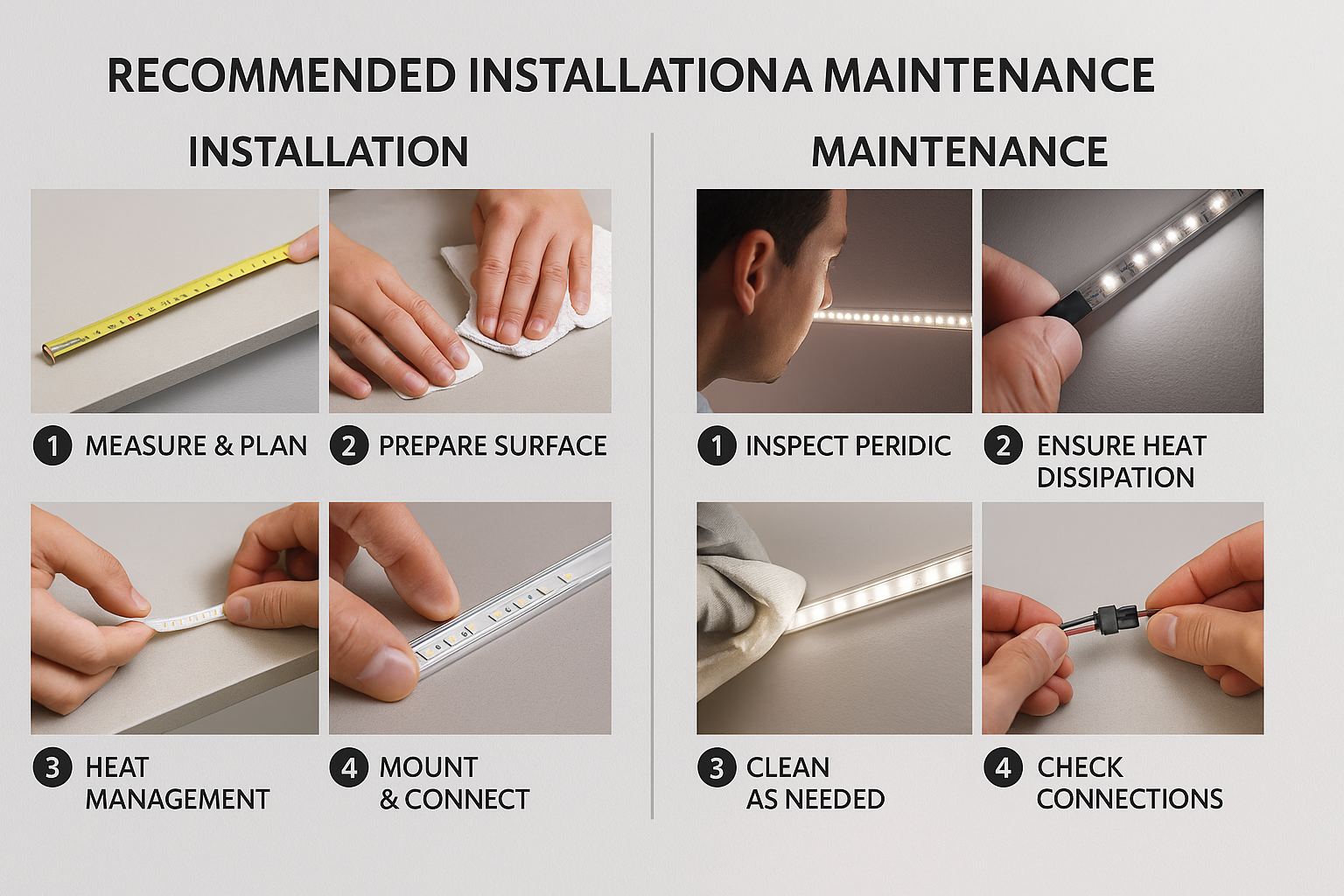
FAQs About 2835 and 3528 LED Strips
Having addressed numerous user inquiries over the years, I’ve compiled and clearly answered the most frequent questions about 2835 and 3528 LED strips to help you make a confident, informed choice.
Are 2835 LEDs brighter than 3528 LEDs?
Yes, clearly, 2835 LEDs offer significantly higher brightness and efficiency compared to 3528 LEDs. They’re ideal for detailed, task-oriented lighting, providing superior illumination clarity and consistency.
Which LED strip is more energy-efficient?
In my experience, 2835 LED strips generally provide better lumen-per-watt efficiency than 3528 LED strips. While 3528 LEDs consume less overall energy due to lower brightness, 2835 LEDs deliver greater illumination efficiency relative to power consumption.
Can I use 3528 LED strips for task lighting?
Clearly, 3528 LED strips typically do not offer the brightness necessary for detailed or task-oriented lighting. For applications demanding higher illumination, clarity, and brightness, 2835 LED strips are the better choice.
Conclusion & Next Steps
Clearly understanding the differences between 2835 and 3528 LED strips enables you to confidently choose the ideal LED strip lighting tailored specifically to your needs. From my personal experience, if your lighting project requires high brightness, superior efficiency, and precise illumination, 2835 LED strips clearly stand out as your best choice. Conversely, 3528 LED strips are perfect for ambient, decorative, and budget-conscious applications due to their moderate brightness, easy installation, and affordability.
Evaluate your lighting requirements clearly—brightness intensity, application area, installation complexity, and budget—to make an informed, confident decision.
Ready to select the perfect LED lighting solution for your project?
Explore Elstar’s LED Lighting Solutions →








